
Submission
doc.: IEEE 802.11-23/0277r1
March 2023
Volker Jungnickel, (Fraunhofer HHI)
IEEE 802 Standards on Light Communication
Date: 2023-03-13
Slide 1
Authors:

Submission
doc.: IEEE 802.11-23/0277r1
March 2023
Volker Jungnickel, (Fraunhofer HHI)
Abstract
IEEE 802 recently finished new standards for optical wireless communications.
802.15.13 introduced a new MAC and two PHY layers enabling high reliability,
low latency, and low power transmission for industrial wireless applications,
and 802.11bb defines how to reuse the 802.11 MAC and OFDM-based PHYs
over optical links, aiming at large-volume applications e.g., in enterprise and
home scenarios. The tutorial presents major use cases, technical solutions, and
recent technology demos in a variety of applications.
Slide 2

Submission
doc.: IEEE 802.11-23/0277r1
March 2023
Volker Jungnickel, (Fraunhofer HHI)
Disclaimer
This presentation should be considered as the personal views of the presenters
not as a formal position, explanation, or interpretation of IEEE.
Per IEEE-SA Standards Board Bylaws, August 2020: At lectures, symposia,
seminars, or educational courses, an individual presenting information on IEEE
standards shall make it clear that his or her views should be considered the
personal views of that individual rather than the formal position of IEEE.
Slide 3

Submission
doc.: IEEE 802.11-23/0277r1
March 2023
Volker Jungnickel, (Fraunhofer HHI)
Outline
• What is Light Communication?
• IEEE P802.15.13
• IEEE P802.11bb
• Technology demos
• Summary
Slide 4

Submission
doc.: IEEE 802.11-23/0277r1
March 2023
Volker Jungnickel, (Fraunhofer HHI)
What is Light Communication?
Slide 5
• Higher capacity/area in small “hotspots”
1…10 Mbps/m² (Wi-Fi 6…7), >100 Mbps/m² (LC)
• High service quality: guaranteed delivery at low latency
robust against jamming
deterministic channel access
• RF is already mature and well established
has issues in dense scenarios
• LC adds new value to RF
important synergies, both indoors and outdoors
• Hybrid RF and LC is better than each technology alone
Key facts
Unique selling points
Strategic use
• Mobile communication by using light
• Mobile, bidirectional, high-speed data
• Complementary to RF
• What is LC?
• Other LC standards
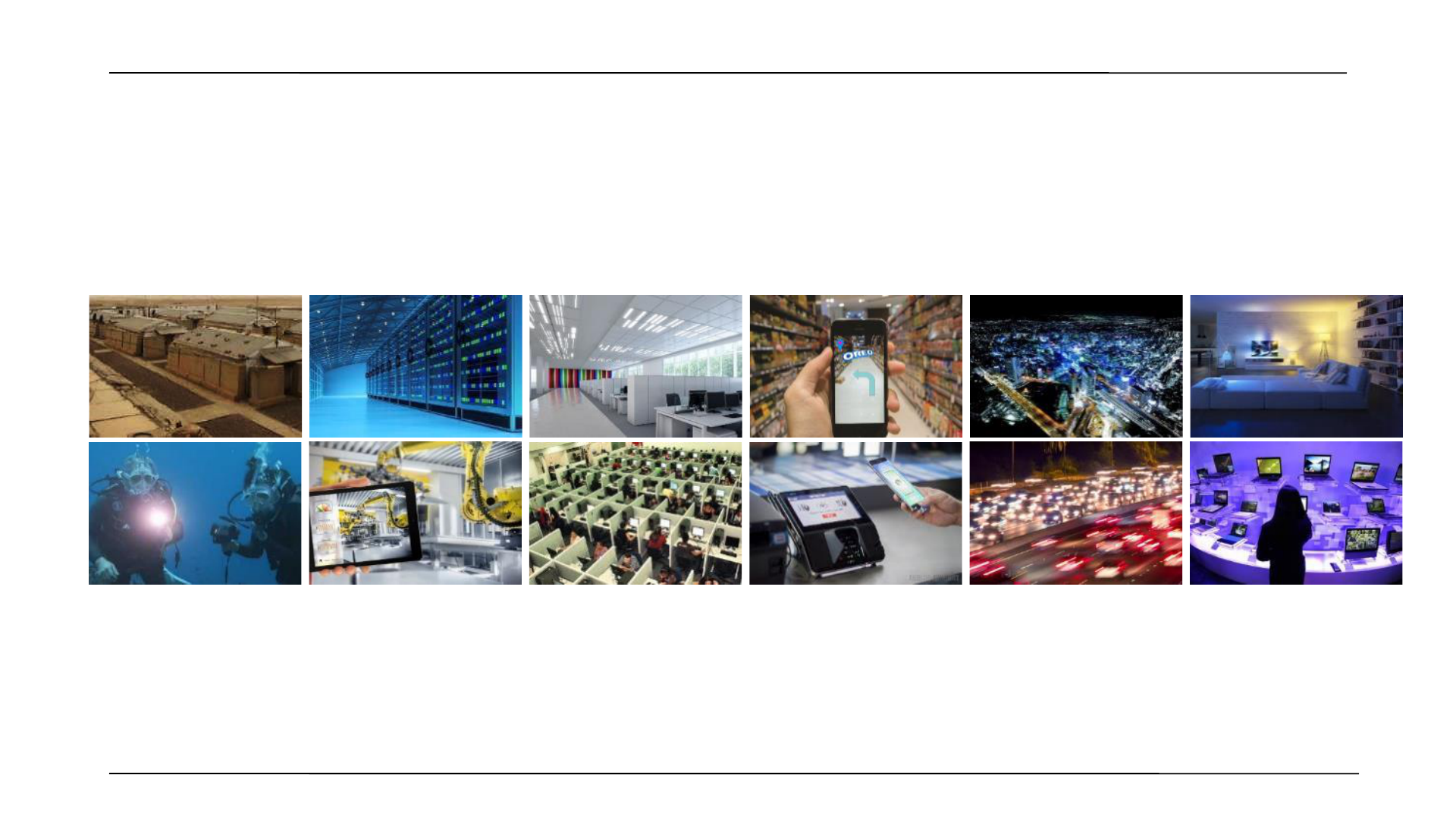
Submission
doc.: IEEE 802.11-23/0277r1
March 2023
Volker Jungnickel, (Fraunhofer HHI)
LC is useful where RF has limitations
6
Field command
Secure comms
Harsh enviro
Underwater
Data centres
Industry 4.0
IoT sensors
Safe enviro
Smart building
Secure comms
Dense network
Net offload
Indoor location
Shop analytics
Payments
Back office
Smart city
Smart transport
Streetlights
Backhaul
Mobile devices
Smart home
Entertainment
Lighting
Defence &
Environment
Data
& Industrial
Office &
Commercial
Retail
& Financial
Smart City
& Transport
Consumer
& Lifestyle
• What is LC?
• Other LC standards

Submission
doc.: IEEE 802.11-23/0277r1
March 2023
Volker Jungnickel, (Fraunhofer HHI)
LC domains
Slide 7
• Light allows connectivity over various distances
• Ultra short range
inter-chip interconnects, in-body networks
• Short-range
optical WLAN, in-flight, car-to-X, indoor positioning, industrial wireless
• Medium-/long range
inter-building, mobile backhaul, underwater
• Ultra-long range
satellite feeder links, satellite-to-satellite

Submission
doc.: IEEE 802.11-23/0277r1
March 2023
Volker Jungnickel, (Fraunhofer HHI)
Slide 8
Taxonomy of LC
Differences types of light communications have different applications.
OCC
Low Speed
Geo Location
Advertisements
Notifications
Optical Camera
Communications
LiFi
Secure high-speed
mobile wireless
communications
Light Fidelity
FSO
Backhaul
Long-distance
communications
Free Space
Optics
• What is LC?
• Other LC standards

Submission
doc.: IEEE 802.11-23/0277r1
March 2023
Volker Jungnickel, (Fraunhofer HHI)
Hybrid RF/LC
Slide 9
• Optical small cells
densify radio-based WLAN
using infrared or visible light
100 Mbit/s … 10 Gbit/s per link
eventually integrated with lighting
• Low-cost off-the-shelf components
LEDs, laser diodes
silicon photodiodes
digital signal processing
Dominic O'Brien, Gareth Parry & Paul Stavrinou Optical hot spots speed up wireless communications Nature Photonics 1, 245 - 247 (2007)
• What is LC?
• Other LC standards
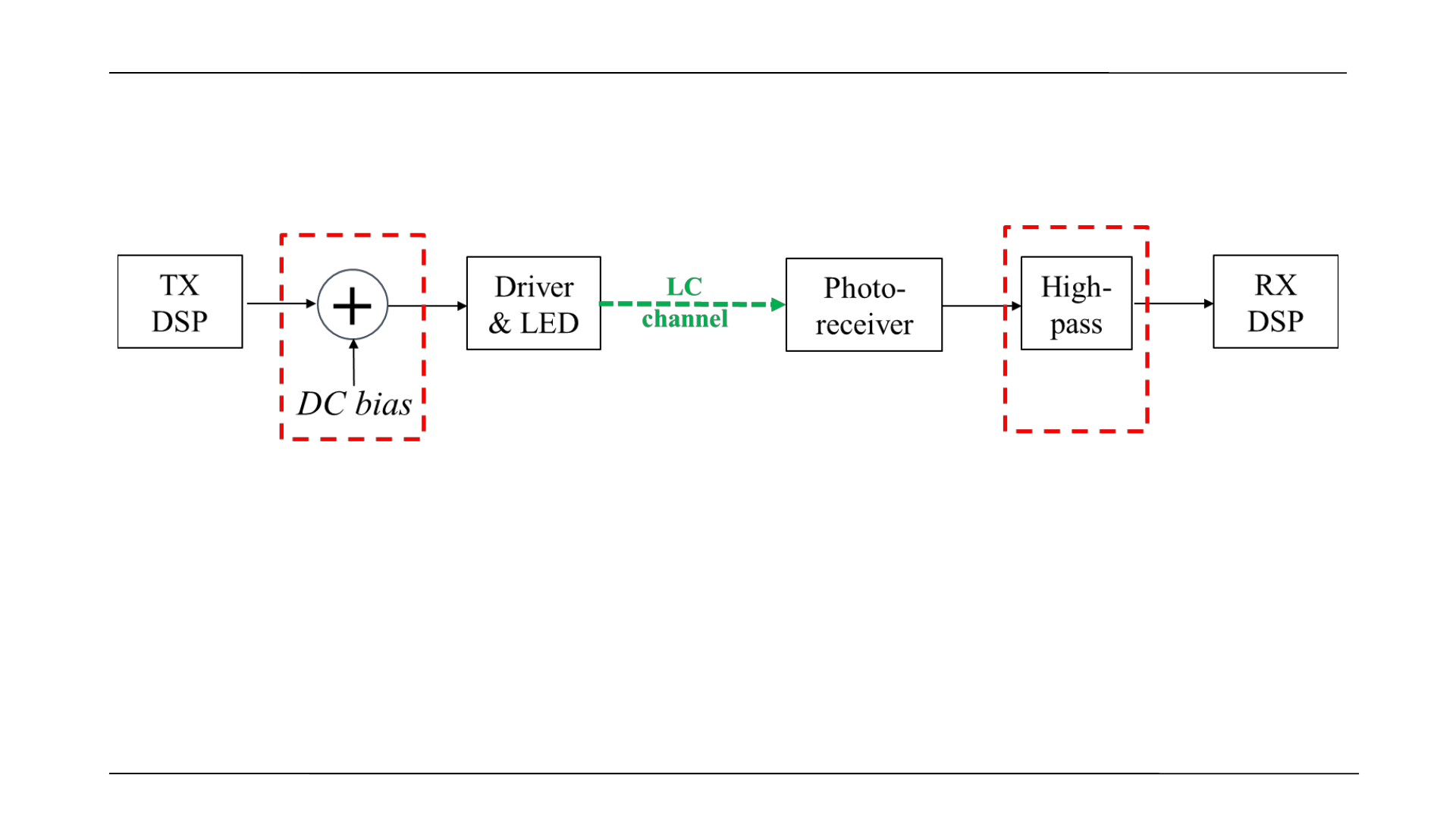
Submission
doc.: IEEE 802.11-23/0277r1
March 2023
Volker Jungnickel, (Fraunhofer HHI)
Slide 10
Basic LC link
• TX and RX DSP can be very similar to RF.
• A real-valued waveform is needed and a bias is added.
• The biased waveform is transmitted by LED and detected by photodiode
• The high-pass removes the DC bias and possible ambient/sun light.
• Only the AC signal is used for communication, in the presence of thermal and shot noise.
• What is LC?
• Other LC standards
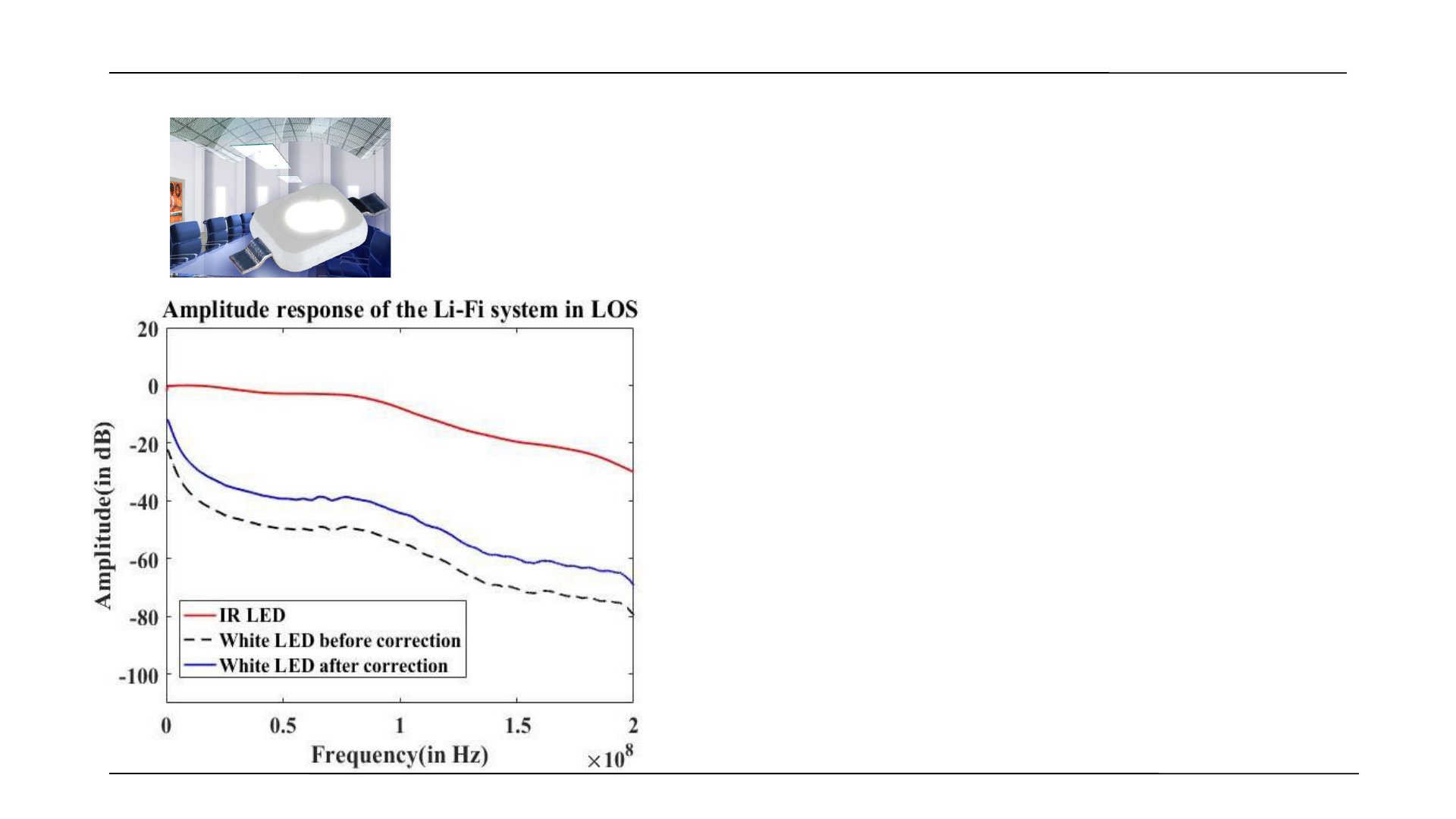
Submission
doc.: IEEE 802.11-23/0277r1
March 2023
Volker Jungnickel, (Fraunhofer HHI)
TX frontend
Slide 11
• Any solid state light source can be used
LEDs, Lasers and VCSELs support different bandwidth
• 802.15.13: UV, VIS and IR betw. 190 nm and 10000 nm
intended for specialty applications
• 802.11bb supports IR between 800 an and 1000 nm
compare IR versus visible light at same drive currents
• IR has 10x more signal and 40x higher bandwidth
conversion from blue to white, phosphor reduces the speed
higher e/o and o/e conversion coefficients in IR vs. blue
Sreelal M. Mana et al, "Experiments in Non-Line-of-Sight Li-Fi Channels," 2019 Global LIFI Congress, Paris, France, 2019
• Introduction
• What is LC?
• Other LC standards

Submission
doc.: IEEE 802.11-23/0277r1
March 2023
Volker Jungnickel, (Fraunhofer HHI)
RX frontend
Slide 12
PIN photodiode
large area, limited sensitivity, low cost
Avalanche photodiode (APD)
smaller area, higher sensitivity, higher cost
Optical concentrator (OC)
increased effective area, reduced field-of-view
Transimpedance amplifier (TIA)
small photocurrent (µA) into useful voltage (V)
Bootstrapping (BS)
increases bandwidth
Jelena. Vucic, Ph.D. thesis, TU Berlin, 2009
• Introduction
• What is LC?
• Other LC standards

Submission
doc.: IEEE 802.11-23/0277r1
March 2023
Volker Jungnickel, (Fraunhofer HHI)
Light propagation
Slide 13
Diffuse link (NLOS)
low power
blocking is less relevant
inherent support for mobility
multipath 1
st
order low pass, reduced bandwidth
• Direct link (LOS)
high power
blocking is critical
no multipath
high bandwidth
BS
diffuse
link
directed
link
BS: base station, MS: mobile station
MS 1 MS 2
• Introduction
• What is LC?
• Other LC standards

Submission
doc.: IEEE 802.11-23/0277r1
March 2023
Volker Jungnickel, (Fraunhofer HHI)
LOS vs. diffuse
Slide 14
• LOS is the dominant signal, if it is free
high power and high bandwidth
• First-order reflections
25 dB reduced power, rather high bandwidth
• Higher-order reflections only
35 dB reduced power, lower bandwidth
Sreelal M. Mana et al, "Experiments in Non-Line-of-Sight Li-Fi Channels," 2019 Global LIFI Congress, Paris, France, 2019

Submission
doc.: IEEE 802.11-23/0277r1
March 2023
Volker Jungnickel, (Fraunhofer HHI)
• IrDA – Infrared Data Association
Founded 1993 to establish interoperable solution for infrared light data networking
Initial IrDA Data standard released in 1994 for P2P communications over IR light
Several amendments with bitrates to 1 Gb/s and providing broad application support
• IEEE 802.15.7
Task Group on Visible Light Communication established in Jan 2009
IEEE Std 802.15.7-2011, later revised to IEEE Std 802.15.7-2018
Now focusing on Optical Camera Communication (OCC)
Other LC standards
Slide 15
• Introduction
• What is LC?
• Other LC standards

Submission
doc.: IEEE 802.11-23/0277r1
March 2023
Volker Jungnickel, (Fraunhofer HHI)
ITU-T G.9991
Slide 16
• G.9991 is used for almost all LC products today
• Based on home networking standard G.996x (G.hn coax mode)
chipsets from multiple vendors are available
• Developed by ITU-T Q18/SG15: In-premises networking
started 2015, first approval April 2019, latest update in April 2021
DCO-OFDM PHY, (DC biased Optical OFDM), adaptive bitloading, up to 2 Gbps
MAC (TDMA, CSMA) allows for Quality-of-Service through medium reservation for transmissions
• Introduction
• What is LC?
• Other LC standards

Submission
doc.: IEEE 802.11-23/0277r1
March 2023
Volker Jungnickel, (Fraunhofer HHI)
Slide 17
New LC standards address different markets
• 802.15.13
high-end capabilities for industrial / medical / FWA markets
new features for increased range, higher reliability, deterministic latency
• 802.11bb
capabilities address the consumer market
easy integration with commercially available chipsets, infrastructures and ecosystem

Submission
doc.: IEEE 802.11-23/0277r1
March 2023
Volker Jungnickel, (Fraunhofer HHI)
IEEE P802.15.13 - Overview
• Focus: Industrial applications
new standard including MAC and PHY
• Goals: Simplicity, low implementation barrier
simplified MAC
basic data transmission w/o security supported
two new PHYs
• Star topology network
coordinator manages the network
members associate with the network
allows P2MP or P2P communication
• Interconnection with 802 LANs
Slide 18
• IEEE P802.15.13
• Architecture & Service
• PHYs
• MAC
• Status
IEEE 802.15.13

Submission
doc.: IEEE 802.11-23/0277r1
March 2023
Volker Jungnickel, (Fraunhofer HHI)
Architecture and service of 802.15.13
• Data transmission always between Coordinator and Members
Coordinator bridges data between two members
Only exception are relays
• MAC Data interface
EUI-48 addresses
Supports 802.1 MAC service
Shim not yet in 802.1AC (t.b.d.)
Slide 19
• IEEE P802.15.13
• Architecture & Service
• PHYs
• MAC
• Status

Submission
doc.: IEEE 802.11-23/0277r1
March 2023
Volker Jungnickel, (Fraunhofer HHI)
Physical layers (PHYs)
Slide 20
• Two physical layers (PHYs) with distinct properties
OOK modulation Energy efficiency
OFDM modulation Spectral efficiency
• Both support important features for LC:
Bandwidth and rate adaptation to OFE and channel properties
MIMO pilots for channel estimation between multiple TX and RX
Cyclic prefix for frequency domain equalization
• Both have similar Physical layer protocol data unit (PPDU) format:
Preamble: for frame detection and channel estimation
Header: information about further PPDU structure
Optional pilots: for MIMO channel estimation
Payload: contains MAC data
• IEEE P802.15.13
• Architecture & Service
• PHYs
• MAC
• Status

Submission
doc.: IEEE 802.11-23/0277r1
March 2023
Volker Jungnickel, (Fraunhofer HHI)
M. Hinrichs et al., "A Physical Layer for Low Power Optical Wireless Communications,"
in IEEE Transactions on Green Communications and Networking, vol. 5, no. 1, pp. 4-17,
March 2021
OOK & OFDM
• OOK: „PM-PHY“
Clock (symbol) rates 12.5 … 200 MHz
Reed-Solomon error coding
8b10b line coding removes DC
Cyclic prefix 160 or 1280 ns
• OFDM: „HB-PHY“ (inspired by ITU-T G.9960)
Bandwidths 50, 100 and 200 MHz
Adaptive bitloading use optical frontend efficiently
LDPC encoding for high performance
Cyclic prefix: 160 to 1280 ns
Slide 21
M. Hinrichs et al., "A Physical Layer for Low Power Optical Wireless Communications,"
in IEEE Transactions on Green Communications and Networking, vol. 5, no. 1, pp. 4-17,
March 2021
• IEEE P802.15.13
• Architecture & Service
• PHYs
• MAC
• Status
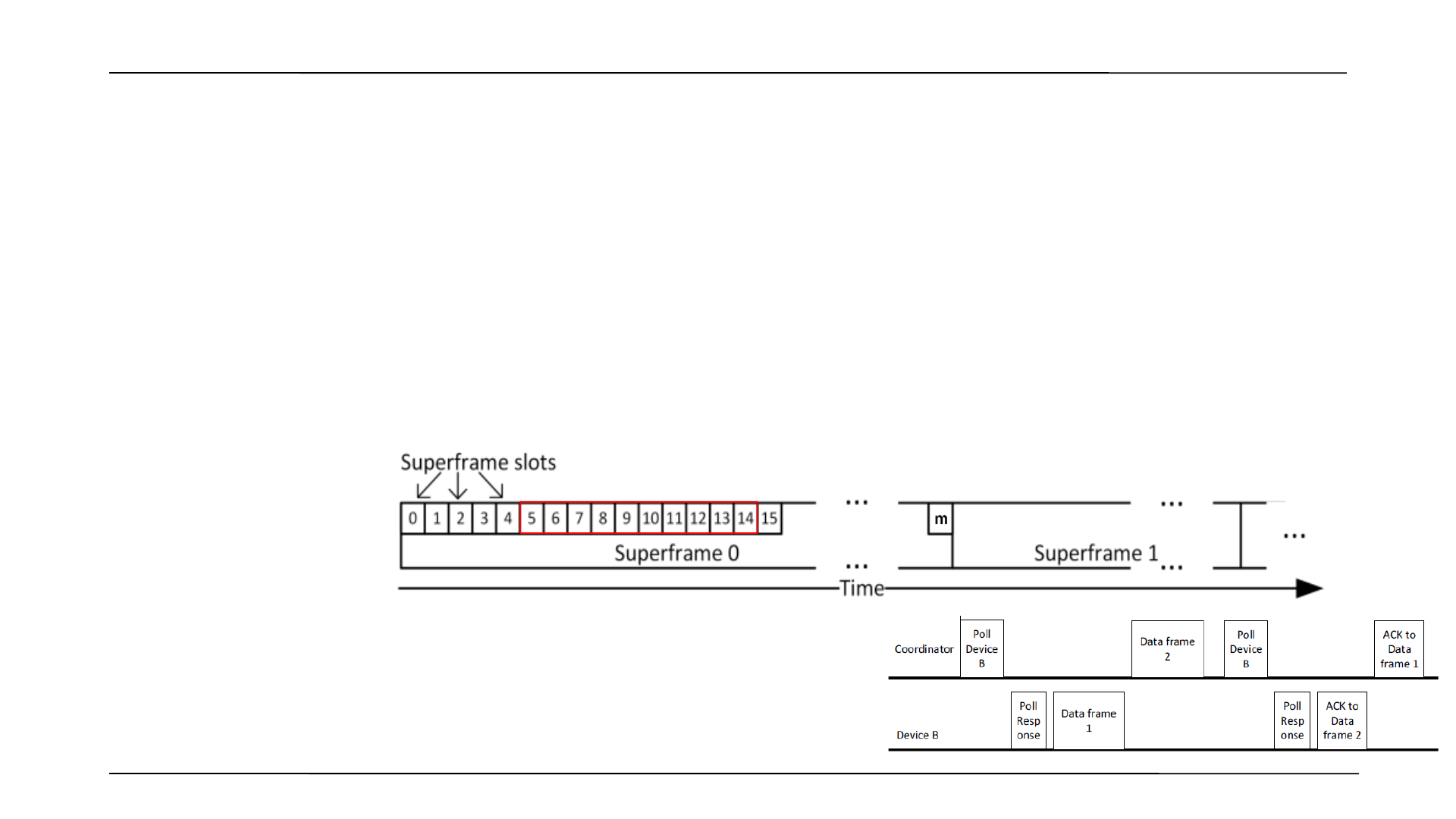
Submission
doc.: IEEE 802.11-23/0277r1
March 2023
Volker Jungnickel, (Fraunhofer HHI)
Channel access in 802.15.13
• Two mechanisms: Scheduled & polled channel access
• Scheduled medium access – TDMA reservations without carrier sensing
Random access & “guaranteed” access in random time slices (RTS) and guaranteed time slices (GTS)
Coordinator transmits control frames for synchronization and slice distribution regularly but in variable slot
Members transmit in allocated slices
• Polled medium access (based on IEEE 802.11 PCF)
Coordinator polls for random and dedicated transmissions
One (dedicated) or more (random) members transmit after
receiving a poll frame
Slide 22
• IEEE P802.15.13
• Architecture & Service
• PHYs
• MAC
• Status

Submission
doc.: IEEE 802.11-23/0277r1
March 2023
Volker Jungnickel, (Fraunhofer HHI)
• Acknowledgment & Retransmission
Single, Block ACK
Both not immediate due to possible fronthaul delay
• PHY rate adaptation feedback
MCS (=clock rate) selection for PM-PHY
Adaptive bitloading for HB-PHY
• Fragmentation & Aggregation
For efficient use of available resources
• One general frame format (MPDU)
Three frame types – data, control, management
Protocol information exchanged in „elements”,
that reside in MPDU payload
Other features in 802.15.13 MAC
Slide 23
• IEEE P802.15.13
• Architecture & Service
• PHYs
• MAC
• Status
Adaptive Bitloading

Submission
doc.: IEEE 802.11-23/0277r1
March 2023
Volker Jungnickel, (Fraunhofer HHI)
Distributed MIMO in 802.15.13
• Multiple optical frontends (OFEs)
Spatial multiplexing & diversity through MISO TX
Spatially distributed OFEs (D-OFE) connected via “fronthaul”
Fronthaul details are implementation-specific
• MIMO Feedback routine for OFE selection
Parallel transmission of orthogonal pilots from OFEs
CSI feedback of member’s observed OFEs to coordinator
Coordinator schedules medium access based on CSI
Slide 24
Two devices multiplexed
in space (green, red)
Other time slice using
all OFEs (blue)
D-OFEs 1,2
D-OFEs 3,4,5
• IEEE P802.15.13
• Architecture & Service
• PHYs
• MAC
• Status

Submission
doc.: IEEE 802.11-23/0277r1
March 2023
Volker Jungnickel, (Fraunhofer HHI)
Relaying in 802.15.13
• Make use of secondary light sources
overcome LOS blocking, enhance the range
• Relay selection
relay and relayed device listen to the environment (learning)
report transmitter addresses of MPDUs to the coordinator
• Significant gains up to 30 dB were observed
suitable relay has a free LOS and it shortens the distance
Slide 25
• IEEE P802.15.13
• Architecture & Service
• PHYs
• MAC
• Status

Submission
doc.: IEEE 802.11-23/0277r1
March 2023
Volker Jungnickel, (Fraunhofer HHI)
Implementation of 802.15.13
Slide 26
• Validation through prototyping
FPGA-based PHY implementation
MAC on general-purpose CPU
Bugs were found and fixed
• Features
PM-PHY is done, HB-PHY is in progress
Next: D-MIMO over Ethernet fronthaul,
relaying
• Test deployments
in medical and industrial environments
projects LINCNET, 5G-COMPASS
• Video about HILIGHT project available
https://www.youtube.com/watch?v=NEWqi_QHUV8
• IEEE P802.15.13
• Architecture & Service
• PHYs
• MAC
• Status

Submission
doc.: IEEE 802.11-23/0277r1
March 2023
Volker Jungnickel, (Fraunhofer HHI)
P802.15.13 is finalized
• Draft D10 is approved for publication by IEEE SA board
• Available in IEEExplore:
https://ieeexplore.ieee.org/document/9963940
• Awaiting publication Q2-3/2023
Slide 27
• IEEE P802.15.13
• Architecture & Service
• PHYs
• MAC
• Status

Submission
doc.: IEEE 802.11-23/0277r1
March 2023
Volker Jungnickel, (Fraunhofer HHI)
Slide 28
IEEE 802.11bb overview
• 802.11bb aims at LC for the mass market
• IEEE 802.11 is the world’s most common communications standard
• Over 3.8 billion Wi-Fi chipsets were shipped globally in 2021 in everything from smartphones, TVs, CCTV
cameras, baby monitors, etc.
• The large established market and open standards have created a highly competitive, vibrant ecosystem of
devices, testing facilities, etc.
• Deploying LC on a global scale requires reducing the barrier to entry for anyone looking
to produce interoperable systems
• IEEE 802.11bb offers the simplest integration route with the highest number of possible
device integration options
• IEEE P802.11bb
• PHY
• Status

Submission
doc.: IEEE 802.11-23/0277r1
March 2023
Volker Jungnickel, (Fraunhofer HHI)
Slide 29
802.11bb PHY concept
• KISS approach: Reuse existing PHYs
and MAC from 802.11
RF frontend up-converts baseband signals
onto e.g. 5.2 GHz
LC frontend up-converts baseband onto
lower IF carrier frequency e.g. 26 MHz in
the case of 20 MHz baseband signal
allows to convert any existing Wi-Fi chip
solution into a LC solution through
adding cheap circuitry
• Same bitrates, same interfaces, same
capabilities like Wi-Fi
Freq
0
Freq
0
5.2 GHz
RF Up-conversion
Freq
0
Freq
0
26 MHz
LC Up-conversion
20 MHz
• IEEE P802.11bb
• PHY
• Status

Submission
doc.: IEEE 802.11-23/0277r1
March 2023
Volker Jungnickel, (Fraunhofer HHI)
Direct Conversion
Slide 30
PHY Implementation options
Up/Down Conversion from RF
Existing Wi-Fi
chipsets
Direct Conversion
Up/Down Conversion from RF
• IEEE P802.11bb
• PHY
• Status

Submission
doc.: IEEE 802.11-23/0277r1
March 2023
Volker Jungnickel, (Fraunhofer HHI)
Slide 31
LC IF mappings from 5 and 6 GHz
• 802.11bb channel mapping
RF channels 1-64 with centre
frequencies from 5.19-5.32 GHz as
a block to LC IF centre frequencies
26-166 MHz
RF channels 1-64 with centre
frequencies from 5.955-6.095 GHz
as a block to LC IF centre
frequencies 206-326 MHz
• IEEE P802.11bb
• PHY
• Status

Submission
doc.: IEEE 802.11-23/0277r1
March 2023
Volker Jungnickel, (Fraunhofer HHI)
Slide 32
Spatial and wavelength multiplexing
Wavelength Division
Multiplexing
1) 800nm – 900nm
2) 900nm – 1000nm
Spatial Multiplexing
• IEEE P802.11bb
• PHY
• Status

Submission
doc.: IEEE 802.11-23/0277r1
March 2023
Volker Jungnickel, (Fraunhofer HHI)
Slide 33
CCA and LC repetition in 802.11bb
• 802.11bb systems shall have the same requirements for Clear Channel Assessment (CCA)
as those for existing Wi-Fi 4, Wi-Fi 5 and Wi-Fi 6 chipsets
• 802.11bb suggests an LC repetition approach where the LC AP immediately retransmits
the received signal from a STA using amplify-and-forward as an example
• IEEE P802.11bb
• PHY
• Status

Submission
doc.: IEEE 802.11-23/0277r1
March 2023
Volker Jungnickel, (Fraunhofer HHI)
Slide 34
P802.11bb is almost finalized
• IEEE P802.11bb D6.0
Approved with 96%
is available at the IEEE store
https://ieeexplore.ieee.org/document/10042199
• Draft 7.0 is currently in third IEEE SA recirculation
ballot closing on 14 Mar
Expected final 802.11 WG approval in Mar. 2023
Expected final 802 LMSC Approval in Mar. 2023
Expected RevCom & SA Board Approval by Jul. 2023
• IEEE P802.11bb
• PHY
• Status

Submission
doc.: IEEE 802.11-23/0277r1
March 2023
Volker Jungnickel, (Fraunhofer HHI)
Mobile device integration
• Video available
https://vimeo.com/734356392
• Minaturized optical antenna
key for integration into mobile devices
multiple optical antennas needed
pointing into different directions
omnidirectional coverage enables mobility
• Applications
device-to-device (D2D) communication
short-range mobile access, e.g. to a desk light
Slide 35
• Technology demos
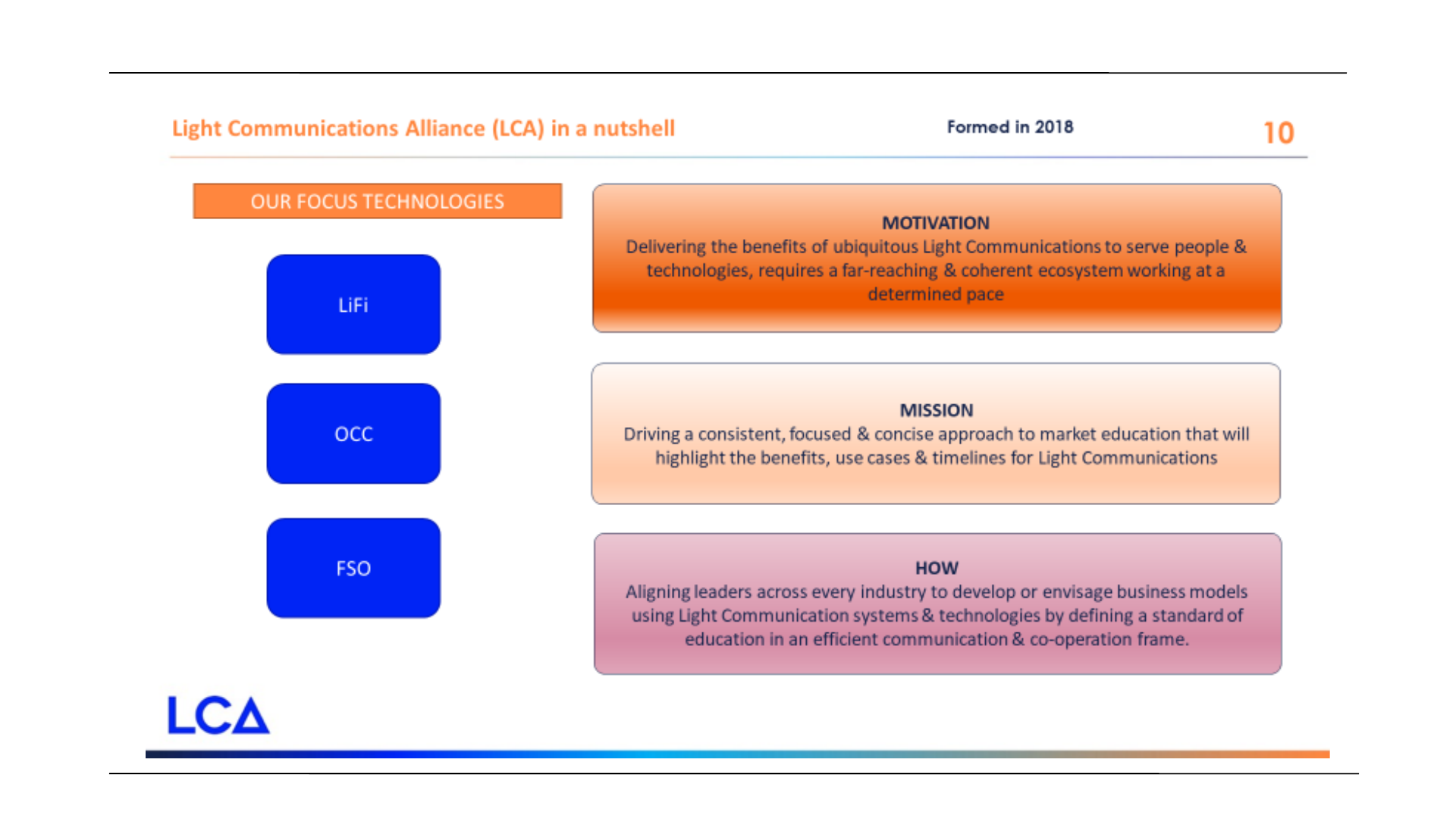
Submission
doc.: IEEE 802.11-23/0277r1
March 2023
Volker Jungnickel, (Fraunhofer HHI)
Slide 36
• IEEE P802.11bb
• PHY
• Status

Submission
doc.: IEEE 802.11-23/0277r1
March 2023
Volker Jungnickel, (Fraunhofer HHI)
Slide 37
802.11bb Next steps
• Support for continued education on the benefits of LC
Consider joining the Light Communications Alliance
http://lightcommunications.org/
• Enable Wi-Fi 7 support for LC
• Identify certification body for LC
• Define certification process
• Develop test specifications
• IEEE P802.11bb
• PHY
• Status

Submission
doc.: IEEE 802.11-23/0277r1
March 2023
Volker Jungnickel, (Fraunhofer HHI)
Industrial Communication
• Video available
https://www.youtube.com/watch?v=tEJkIPv2KIA
00:30…02:49
• Integration of a distributed LC cell in 5G SA
network
via Non-3GPP Interworking Function (N3IWF)
seamless mobility between LiFi and 5G
Slide 38
• Technology demos

Submission
doc.: IEEE 802.11-23/0277r1
March 2023
Volker Jungnickel, (Fraunhofer HHI)
Classrooms
• Video available:
https://www.youtube.com/watch
?v=8KH6FHuVa6M
00:00…03:00
• LC in a class room
Multiple LC frontends at the
ceiling next to luminaires
Dongles with USB-C interface
1 Gbit/s DL, 100 Mbit/s UL
Slide 39
• Technology demos

Submission
doc.: IEEE 802.11-23/0277r1
March 2023
Volker Jungnickel, (Fraunhofer HHI)
Residential
• Video available
https://youtu.be/NbcmVXobGW0
00:00…01:30 and 02:24…04:25
• Living room covered by LC
at KPN location in the harbor of Rotterdam/NL
large area coverage with Signify TrueLiFi
hotspot area covered by HHI Gbit LiFi link
• Integration with other technologies
powerline communication used as backhaul
handoff between Wi-Fi and LiFi
Slide 40
• Technology demos

Submission
doc.: IEEE 802.11-23/0277r1
March 2023
Volker Jungnickel, (Fraunhofer HHI)
Fixed Wireless Access
• Video available
https://youtu.be/rpA9XrO2XqY
00:31…04:22
• Broadband access service via LC
Wireless-to-the-Home (WttH)
• Transmission through window glass
RF is blocked, LC goes through
• High quality FWA link
1 Gbit/s, < 1 ms latency, < 1 % loss
• High reliability
weather-independent performance
• Applications
high-speed Internet, video streaming
Slide 41
• Technology demos
Distribution Node (DN)
Client Node (CN)
Media Converter (MC)

Submission
doc.: IEEE 802.11-23/0277r1
March 2023
Volker Jungnickel, (Fraunhofer HHI)
Industrial AIoT
• Video available
https://etri.gov-dooray.com/mail/big-
files/4663576d494c7333-255f35fc968ff277-
306a05e75fec5df8-1870353be84
• Safety management using LC
two cameras estimate the distance of
people moving around the forklift
one has Artificial Intelligence of Things
(AIoT) functionality, the other has not
via LC, the other camera connects to AIoT
this way, a joint decision can be made and
a security alert is issued in case of risk
Slide 42
• Technology demos

Submission
doc.: IEEE 802.11-23/0277r1
March 2023
Volker Jungnickel, (Fraunhofer HHI)
Industrial Positioning
• Video available
https://www.youtube.com/watch?v=tEJkIPv2KIA
00:31…01:21 and 02:10…03:25
• LC allows precise positioning
LOS is primary propagation path higher precision
measurements available in PHY (synch, MIMO pilots)
triangulation with distributed MIMO 3D position
• 3 cm error in 3D is demonstrated
after sophisticated calibration routine
near-realtime demonstration in Weidmüller factory
• Applications
„indoor GPS“ for automated guided vehicle (AGV)
aid artificial intelligence (AI) with context information
Slide 43
• Technology demos
before
calibration
after
calibration

Submission
doc.: IEEE 802.11-23/0277r1
March 2023
Volker Jungnickel, (Fraunhofer HHI)
Summary
• LC is promising in applications where RF is limited.
Optical frontends use solid state lighting devices with driver and photodiodes with amplifier.
Light travels primarily through LOS, unlike RF.
• IEEE 802 has developed two new standards for LC.
802.15.13 for industrial/medical applications
802.11bb for residential/consumer applications.
• Prototypes and early products are available for testing.
fixed wireless access, industral communication and positioning, residential and home applications.
• Proposed next step is hybrid integration of LC and RF.
Slide 44
• Summary
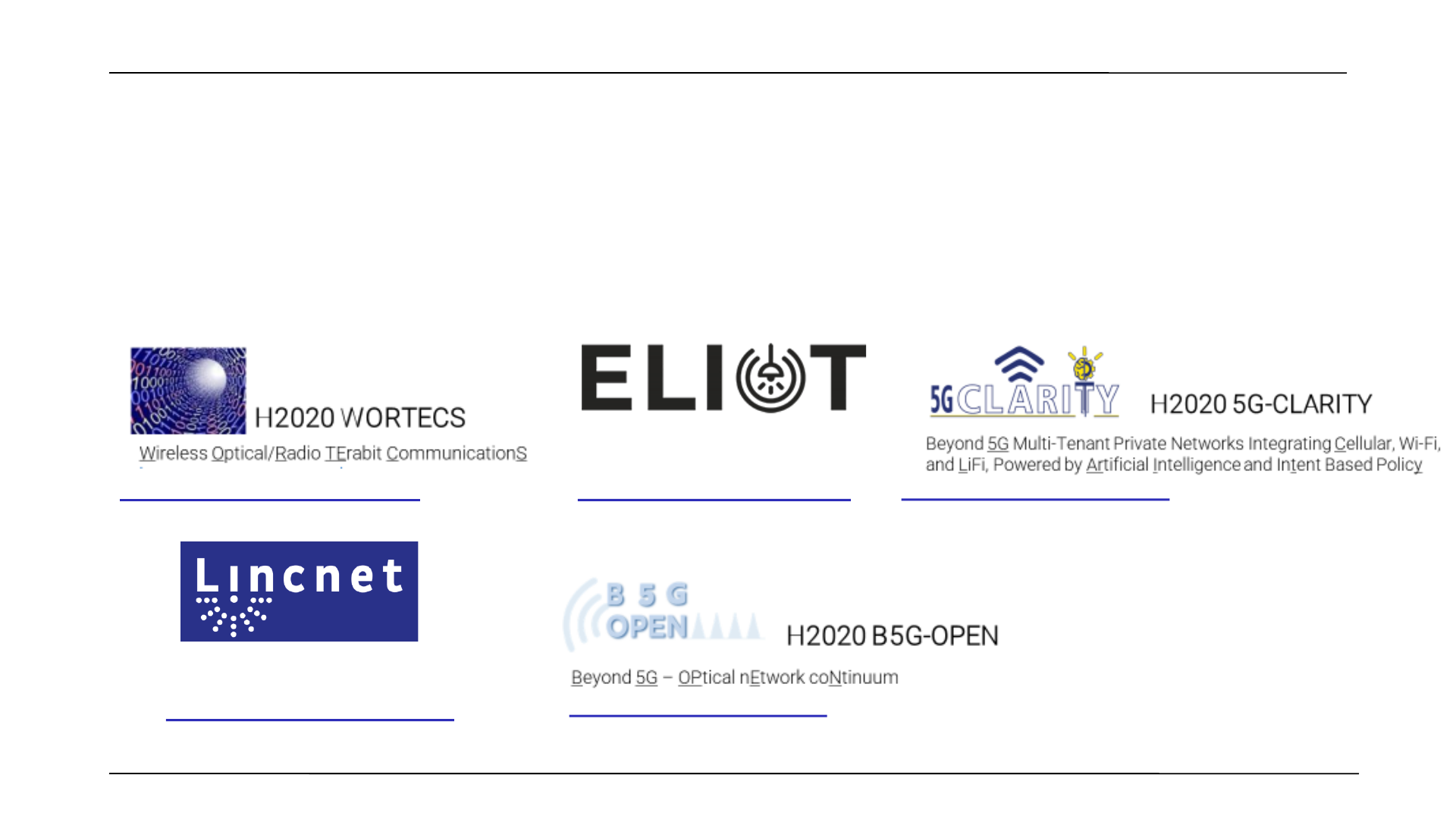
Submission
doc.: IEEE 802.11-23/0277r1
March 2023
Volker Jungnickel, (Fraunhofer HHI)
International efforts
● A variety of projects has contributed to the development of light communication.
Slide 45
LiFi-based 5G for industrial and
medical networks (BMWK, 2022-24)
https://www.lincnet.de/en-gb
https://wortecs.eurestools.eu/ (EU, 2017-20)
https://www.5gclarity.com/ (EU, 2019-22)
https://www.b5g-open.eu/ (EU, 2021-24)
H2020 Enhance Lighting for the
Internet of Things (EU, 2018-22)
https://www.eliot-h2020.eu/
5G-COMPASS
Convergent Open Mobile and secure
Provider-ASSisted 5G indoor and
hotspot network
(BMDV, 2023-24)

Submission
doc.: IEEE 802.11-23/0277r1
March 2023
Volker Jungnickel, (Fraunhofer HHI)
Backup
Slide 46

Submission
doc.: IEEE 802.11-23/0277r1
March 2023
Volker Jungnickel, (Fraunhofer HHI)
LC vs. RF
Slide 47
• Light spectrum is unregulated, similar like RF in ISM bands, limited by eye safety
• Communication is possible wherever the light goes
• LC has shorter range and is more directional than RF
• While RF often propagates via multi-path, light travels primarily via the LOS

Submission
doc.: IEEE 802.11-23/0277r1
March 2023
Volker Jungnickel, (Fraunhofer HHI)
TX frontend: LEDs
Slide 48
• Low-cost high-power LEDs became available, e.g. for lighting
• For data transmission, LED can be modulated at high speed
• Flicker is invisible for the human eye
• Blue LED + phosphor
blue LED is fast (~20 MHz)
phosphor is slow (1-2 MHz)
• R+G+B type
wavelength-division multiplexing (WDM 802.11bb)
~20 MHz per color
higher cost

Submission
doc.: IEEE 802.11-23/0277r1
March 2023
Volker Jungnickel, (Fraunhofer HHI)
Directed and diffuse link
Slide 49
• Channel response depends on
Rice factor
delay Δτ between direct and diffuse link
• Compound channel is frequency-selective
rare “fading” effects
when LOS and NLOS are similarly strong
in room corners, or when Tx and/or Rx are tilted

Submission
doc.: IEEE 802.11-23/0277r1
March 2023
Volker Jungnickel, (Fraunhofer HHI)
Distributed MIMO
Slide 50
• 6 optical frontends, 4 users
• can be considered as distributed MIMO
• measured with LC channel sounder
• channel rank depends on user location
Sreelal M. Mana et al., "Distributed MIMO Experiments for LiFi in a Conference Room," 2020 12th CSNDSP, Porto, Portugal, 2020
Channel
rank = 1
Channel
rank = 2
Channel
rank = 4

Submission
doc.: IEEE 802.11-23/0277r1
March 2023
Volker Jungnickel, (Fraunhofer HHI)
Fronthaul technologies for LC
Slide 51
Polymer Optical Fiber (POF)
Powerline Communications (PLC)
Power-over-Ethernet (PoE)
LC-over-PLC
MWC 2023
Fraunhofer
HHI, devolo
LC-over-POF
ECOC 2022
Fraunhofer-HHI
LC-over-PoE
Signify 2021

Submission
doc.: IEEE 802.11-23/0277r1
March 2023
Volker Jungnickel, (Fraunhofer HHI)
How to encode over LC channel
Slide 52
• LC is baseband channel, starting from DC up to some upper BW
• You and Kahn provided an upper bound on LC capacity (TMS bound)
• Vucic provided a formula for TMS bound in frequency-selective LC channel
opt
opt
1
1
22
2
2
O
bit
SC 2 opt
s
1
D
log 4 2
N
N
n
n
P
C B H N
N
n
effective SNR
B
SC
subcarrier bandwidth
optimal no. of carriers
P
O
optical power
h optical path gain
N
D
detector noise
opt
1NN
R. You and J. Kahn, „Upper-bounding the capacity of optical IM/DD Channels with multiple-subcarrier modulation and fixed bias using trigonometric moment space
method“, IEEE Trans. Inf. Theory, Vol. 48, No. 2, Feb. 2002
J. Vucic, Ph.D. thesis, TU Berlin, 2009

Submission
doc.: IEEE 802.11-23/0277r1
March 2023
Volker Jungnickel, (Fraunhofer HHI)
Optimized TMS bound
Slide 53
• Maximize the bound using N
opt
• Diffused link: low-frequency subcarriers are used
• Direct link: all subcarriers are used
SC
O
100 MHz, 1 = 63,
/ const.,
400mW, 1 A/W
BN
B B N
P
10 20 30 40 50 60
0
100
200
300
400
500
600
Number of used channels
Spectral efficiency [bit/s/Hz]
K=-15 dB
K=-5 dB
K=5 dB
K=15 dB
K=25 dB
Number of used subchannels
(best channels out of 63)
C/B
SC
[bit/s/Hz]
-15 -10 -5 0 5 10 15 20 25
0
10
20
30
40
50
60
70
K-factor [dB]
Optimal number of used channels N
used
N = 64
N = 32
N = 16
Optimal
number
of used
channel
N
opt
diffuse
direct
Jelena Vucic, Ph.D. thesis, TU Berlin, 2009
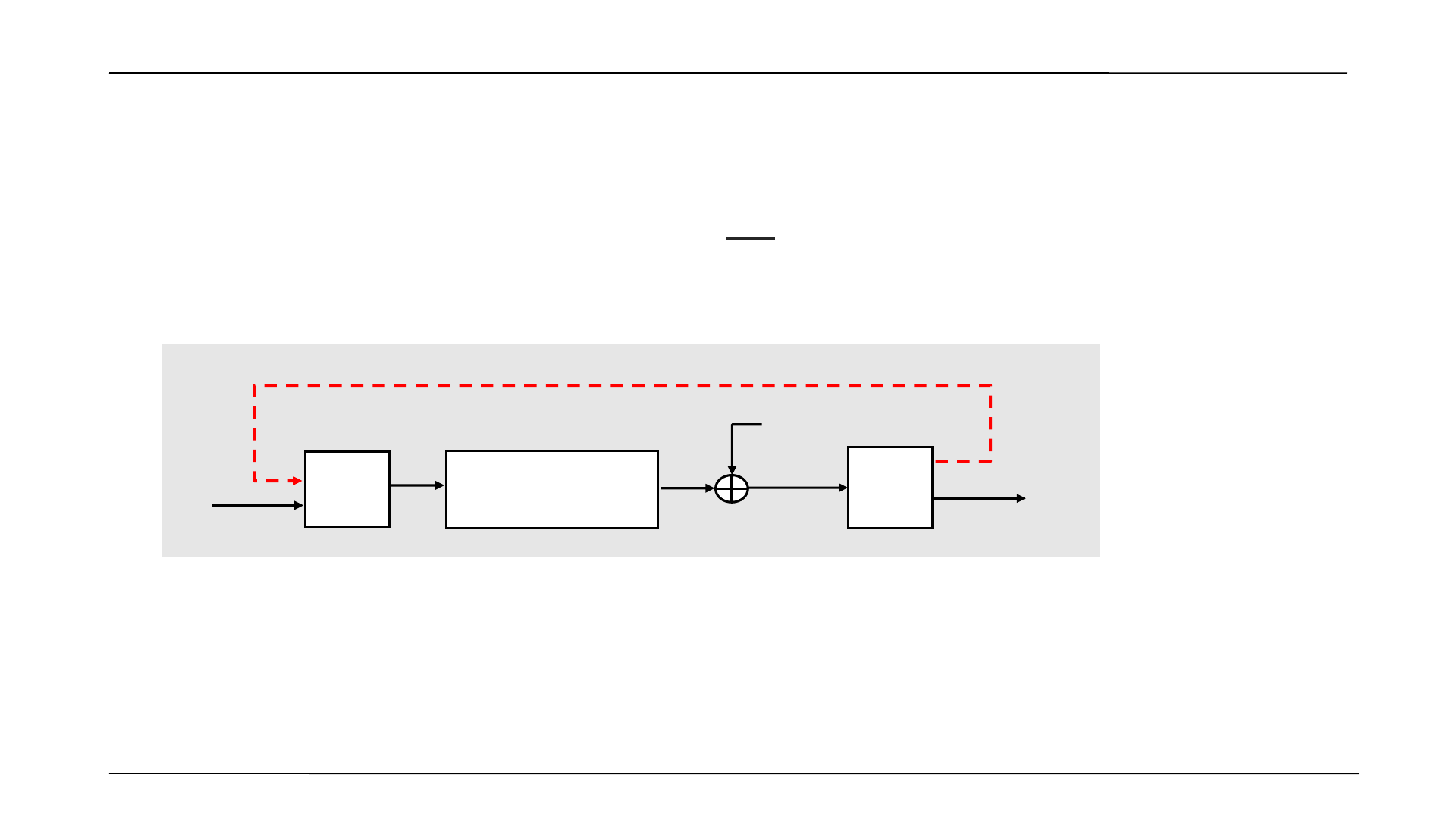
Submission
doc.: IEEE 802.11-23/0277r1
March 2023
Volker Jungnickel, (Fraunhofer HHI)
• Mobile LC channel is frequency-selective and time variant
• Rate-adaptive approach based on feedback over the reverse link
• Compensation of channel dispersion effects
Orthogonal frequency-division multiplex (OFDM)
Adaptive bitloading
Implementation
Slide 54
J. Grubor et al. „Capacity Analysis in Wireless
Infrared Communication using Adaptive Multiple
Subcarrier Transmission, ICTON We C2.7, 2005.
Tx
Rx
OW channel
Channel quality information
Ambient light
Data in
Data out

Submission
doc.: IEEE 802.11-23/0277r1
March 2023
Volker Jungnickel, (Fraunhofer HHI)
Controlled clipping
Slide 55
• LC waveform is clipped below zero in the digital domain
• Clipping is tolerated while errors are corrected
- needs powerful forward error correction, such as LDPC
- retransmissions (selective repeat)
• Link adaptation with controlled clipping
inner loop: adaptive bit-loading using fixed thresholds
outer-loop: adapt all bit-loading thresholds so that desired error rate is reached
k
0
X
0
2X
0
xk
LD
CL
IFFT
G
CP
Graph from NSN
Jelena Vucic, Ph.D. thesis, TU Berlin, 2009

Submission
doc.: IEEE 802.11-23/0277r1
March 2023
Volker Jungnickel, (Fraunhofer HHI)
Efficient coding over LC channels
Slide 56
• Red is the upper bound using TMS
• DCO-OFDM with waterfilling
Green: Clipping is nearly avoided
Blue: 10% clipping probability
• Gap to the TMS bound is very small
• DC-OFDM with waterfilling and controlled
clipping is near to the TMS bound
P
opt
=400 mW, h=1A/W, B=100 MHz, N=64
J. Vucic, Ph.D. thesis, TU Berlin, 2009

Submission
doc.: IEEE 802.11-23/0277r1
March 2023
Volker Jungnickel, (Fraunhofer HHI)
VCSEL arrays: Bandwidth like mm-wave
Slide 57
Vertical cavity surface emitting laser (VCSEL)
circular beam shape, few mW per VSEL
20-30 GHz bandwidth for single VCSELs
VCSEL arrays
100s of VCSELs combined, parasitic L/C
similar area and beam shape like LED
Available for mass-market
developed for LIDAR, also useful die LC
large VCSEL arrays still have few GHz BW
2.5 Gbaud demonstrated in large coverage area
10 W
4 W
3 W
2 W
few mW
M. Hinrichs et al. Demonstration of 1.75 Gbit/s VCSEL-based Non-Directed Optical Wireless
Communications with OOK and FDE ECOC 2022, paper We5.52

Submission
doc.: IEEE 802.11-23/0277r1
March 2023
Volker Jungnickel, (Fraunhofer HHI)
Future: Individually addressable arrays
Slide 58
Select pixels in the TX array
illuminate only the sector where the Rx is located
pixel groups: complexity vs. energy savings
higher bandwidth, use of drivers from fiber optics
Select pixels in the RX array
smaller PD area = higher bandwidth
bootstrapping becomes obsolete lower noise
spatially selective RX to suppress unwanted interference
from ambient light or other mobile devices
spatial multiplexing
V. Jungnickel et al., Electronic Tracking for Wireless Infrared Communications,
IEEE Trans. Wireless Commun., Vol. 2, No. 5, Sept. 2003

Submission
doc.: IEEE 802.11-23/0277r1
March 2023
Volker Jungnickel, (Fraunhofer HHI)
Impact of arrays
Slide 59
• Shown results are for critical scenario
LOS signal is increased
NLOS signal is reduced
• RX power and bandwidth are increased
• Moderate sector sizes will be enough
No need for pencil beams
V, Jungnickel et al., Electronic Tracking for Wireless Infrared Communications,
IEEE Trans. Wireless Commun., Vol. 2, No. 5, Sept. 2003
